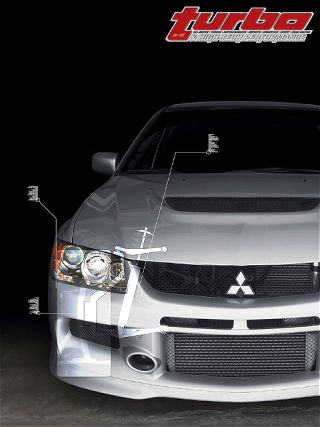 | AWD Alignment Tips What To Do, Why To Do It - Garage
| AWD Alignment Tips What To Do, Why To Do It - Garage
Dismissing everything else and chocking up the AWD platform as the answer to automotive invincibility is easy. With all four wheels getting work done, lesser drivers can surely bend the laws of physics, pulling off maneuvers that would otherwise send less-equipped vehicles to their metal crunching end. But this just isn't the case. Although AWD can prove to be an asset in regards to safety and cornering, the fact that your all-mighty EVO or brute of an STi has more in common with a FWD econobox than practically anything else when it comes to chassis setup just might surprise you.
Why, you ask with that touch of dismay. The answer is that most AWD cars share one major thing in common with the typical FF (front-engine, front-wheel drive) sedan - most of the weight is over the front wheels, distributing out percentage-wise to at least 60/40. Even the Skyline GT-R is saddled with such tonnage over its front wheels. Most AWD cars like the DSM triplets, the EVO, the Audi Quattros and the WRX/STi, share most of their chassis components and drivetrain layouts with their FWD counterparts. Transfer cases and other bits of AWD hardware add additional weight over the front wheels. For example, the GT-R has the heavy iron-block RB26DETT up front and a drivetrain that weighs a figurative ton. Because of this, many chassis settings used to make AWD cars stick are similar to those of a well set up FF car.
Robert Fuller of Robispec once summed things up pretty well: "Most AWD cars are really FWD cars except they come off the corners better." There are exceptions though. The Porsche Carrera and the Skyline GT-R behave more like RWD cars but for different reasons; most of the Porsche's weight is over the rear wheels and the GT-R's ATTESSA torque biasing system attempts to shift as much torque to the back of the car as possible. Thus a GT-R behaves more like a FR (front-engine rear-wheel drive) sports car and requires a somewhat different setup. The EVO, Audi A4 and S4 Quattro have aftermarket center differentials that distribute a larger percentage of torque (60-70 percent) to the rear wheels. The STi has a center differential with an adjustable torque split able to supply up to 70 percent of torque rearward when adjusted accordingly. These vehicles also behave more like the GT-R.
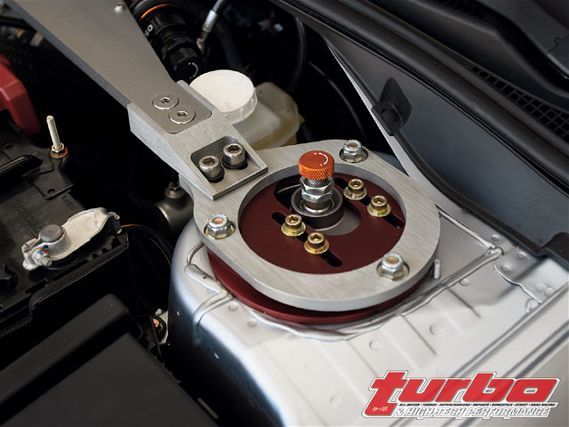 | Before attempting an alignment, there has to be something to actually adjust. Eccentric cam bolts and camber plates can be used to adjust alignment settings on vehicles equipped with MacPherson strut suspensions. Multi-link suspension vehicles use adjustable ball joints and various links for adjustability.
| Before attempting an alignment, there has to be something to actually adjust. Eccentric cam bolts and camber plates can be used to adjust alignment settings on vehicles equipped with MacPherson strut suspensions. Multi-link suspension vehicles use adjustable ball joints and various links for adjustability.
There are two reasons you'll do an alignment: because you have to or because you know you should. A poor alignment will cut a decent set of tires' lifespan in half, but it will also make a good and otherwise well-handling car turn like crap. Either way, measurements like camber, caster and toe need to be set up properly, whether the goal is prepping a Time Attack car that won't lose or just preserving a cheap set of radials from Wal-Mart. The terminology's the same and the procedures are similar, but alignment settings when concerning an AWD car vs. front- and rear-wheel drive cars are slightly different.
Before going any further, it's assumed that those reading are interested in getting the most out of their suspension, not maximizing tire wear or something weenie like that.
Make it Adjustable:
Chassis adjustability is an important element when searching for grip but is often the most ignored. Sexy, adjustable coilovers and big anti-rollbars get a lot of attention, but being able to adjust camber, caster and toe are just as critical and usually ignored by most enthusiasts. Most of the cars we're talking about are only adjustable for toe or have very limited camber adjustability. So before you start, make sure your car is equipped with camber plates and adjustable links.
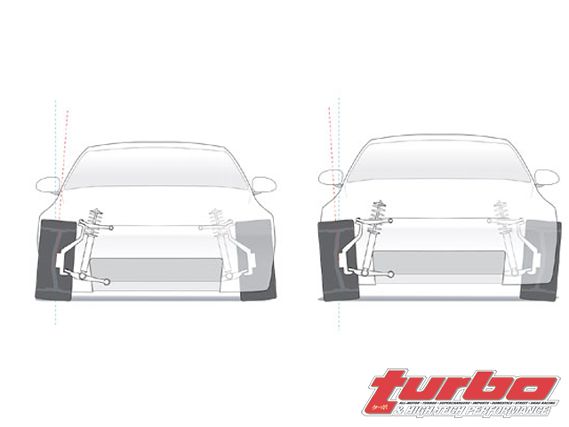 | negative camber/positive camber
| negative camber/positive camber
The Basics: Springs, Anti-Sway Bars and Shocks
A brief suspension primer is in order. Since most AWD cars exhibit a front-weight bias, they tend to understeer and as such need a disproportionately larger amount of rear roll stiffness to help counter this when compared to a typical FR sports car. AWD vehicles require more rear spring and/or rear bar, pretty close to what works well in a FWD car. For serious autocrossing, track days and racing, the standard rear suspension spring rates usually offered by Japanese coilover makers tend to be too soft in proportion to the front, however this remains debatable by many suspension experts. The ratio of front and rear stiffness offered is more appropriate for street driving. Such companies also seem to do the same thing concerning FWD cars. If you're a capable driver participating in many track events, you're better off ordering stiffer rear springs than what's typically offered. For track use, EVOs and DSMs should be fit with slightly stiffer rear springs, while Subarus require fairly equal rates at both ends erring slightly stiffer up front.
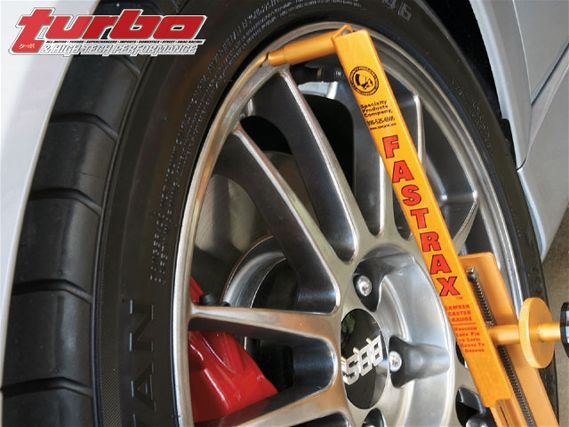 | AWD Alignment Tips What To Do, Why To Do It - Garage
| AWD Alignment Tips What To Do, Why To Do It - Garage
Tip 1: Add Negative Camber
Camber is the inward or outward tilt of the tires when viewing them from the front. Positive camber is when the top of the tire tips outward. Negative camber is when the top of the tire tilts inward. A tire must use its contact patch efficiently to generate its maximum grip potential. Thanks to problems like tire distortion and production car-compromised suspension geometry, this rarely happens. When a tire is subjected to side load its sidewalls flex, digging the outside tread into the ground and lifting its inside into the air. If you drive hard, you've probably noticed the outside edge gets chewed up faster than the rest of the tread. As a car rolls into a corner, the chassis roll tilts the tire onto its outside edge, worsening the problem. Keeping the tires flat on the road is the primary reason to add negative camber and combat tread lift. Since AWD cars have a large percentage of weight over the front wheels, they require more negative camber up front when compared to other drivetrain types - about the same amount that a FF sedan needs. Dialing in negative camber helps combat tread lift and wheel tilt. Camber also creates a force that pushes the car inward. This force is called camber thrust and is used to increase cornering abilities since it's much greater on the heavily loaded, outside tires.
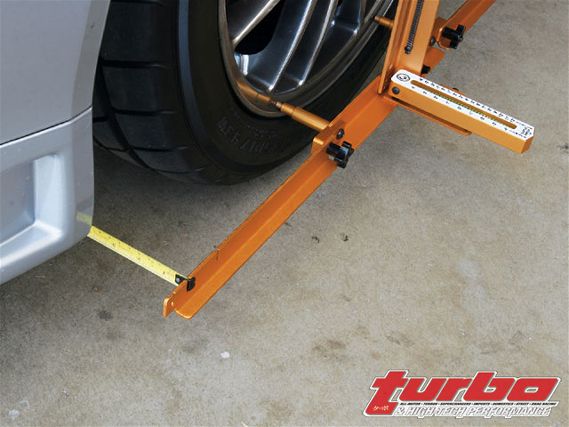 | SPC Performance also offers an optional toe adapter for the FasTrax. The brackets fasten to the FasTrax system, giving users a suitable place to reference toe measurements from. Dialing in toe properly is critical, as improper toe is one of the quickest ways to destroy a new set of tires.
| SPC Performance also offers an optional toe adapter for the FasTrax. The brackets fasten to the FasTrax system, giving users a suitable place to reference toe measurements from. Dialing in toe properly is critical, as improper toe is one of the quickest ways to destroy a new set of tires.
The trick is to add just enough negative camber so the tread stays flat and engaged with the ground under side load and roll. Adding too much negative camber will hurt more than it will help. Excessive negative camber will reduce braking traction, reduce acceleration traction, increase the tendency to tramline (following cracks and grooves in the pavement), increase crown sensitivity (wandering caused by road contour) and affect tire wear (the insides of the tire tread will wear faster with more negative camber if you don't corner hard; conversely, if you constantly corner hard, your tires will wear more evenly and last longer).
Adjusting camber is worth the effort. Optimizing camber for your type of car and driving style can often make a bigger difference in the amount of stick generated than just about any other mod, besides tires.
Vehicle types and driving demands together determine how much negative camber is needed. Aggressive drivers should use more. Those concerned about tire life while commuting should use less. Suspension design also matters. MacPherson strut cars like the WRX/STi, DSM and EVO front suspensions need more negative camber to work well under cornering load; multi-link suspensions like those found on the rear of the DSM and EVO and the Skyline GT-R generally need less negative camber. Softer suspended cars that lean over in turns generally need more negative camber to grip well.
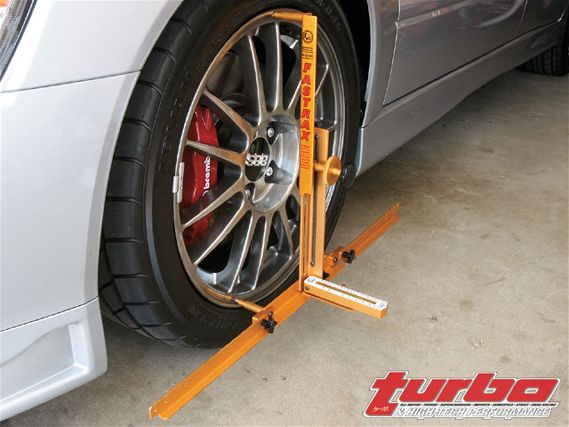 | SPC Performance's FasTrax Adjustable Camber/Caster Gauge allows users to adjust camber, caster and toe accurately and affordably. The kit includes the mounting setup and gauge that reads -4 degrees to +4 degrees camber and -4 degrees to +12 degrees caster. Our setup mounts up to most any 13-18-inch wheel but other size kits are available.
| SPC Performance's FasTrax Adjustable Camber/Caster Gauge allows users to adjust camber, caster and toe accurately and affordably. The kit includes the mounting setup and gauge that reads -4 degrees to +4 degrees camber and -4 degrees to +12 degrees caster. Our setup mounts up to most any 13-18-inch wheel but other size kits are available.
Tip 2: Tune Your Toe
Toe is the direction a car's tires are pointed relative to each other when viewed from above. Toe-in means the front of the tires are closer to each other than the rears. Toe-out is the opposite. Fine-tuning toe settings allow a measure of control that's often overlooked. It also has a significant affect on how a car behaves in a corner. Front toe settings make a big difference in how a car handles during the first third of a turn, the critical turn-in phase where cornering force is initiated. Rear toe settings are critical for helping an AWD car get on the gas while exiting a corner harder and sooner. Excessive toe-in or toe-out will cause tire wear on the outside and inside edges of the tire respectively and can ruin one very quickly. Any toe setting past an 1/8-inch either way has a negative affect on tire life. Too much toe has probably ruined more tires on lowered cars than just about any other attribute, including camber.
Tip 3: Adjust Caster
Every car's front wheels steer on pivots attached to the suspension. Caster is the angle from vertical of an imaginary line drawn through the spindle's pivots, measured in degrees. The caster is positive if the top pivot point is behind the lower pivot point, meaning the caster angle slopes backward like on a bicycle (as viewed from the side). If the angle slopes forward, the caster is negative. No cars have negative caster so don't worry about it.
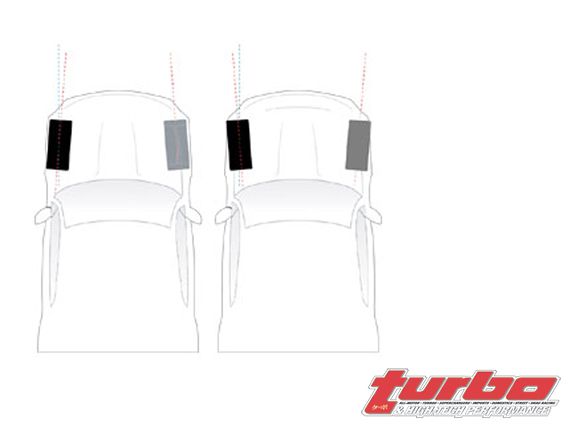 | toe-out/toe-in
| toe-out/toe-in
Increasing positive caster projects the point where the steering axis meets the ground further in front of the tire's contact patch. This distance is called caster trail. When the tire's contact patch is behind this point, the tires want to stay centered behind it, much like a shopping cart's casters naturally lining up in the direction of travel with the wheel's contact patch behind the caster's pivot point. Like the shopping cart caster, the lever arm created between this point and the tire's contact patch creates torque, which causes the steering to self-align in a forward direction. The driver perceives this self-aligning reaction as greater stability and on-center steering feel.
Lots of positive caster causes the outside wheel to gain beneficial negative camber in a turn. Think of a parked chopper with the wheel flopped to the side. That's an extreme example of negative camber gain with positive caster. But excessive positive caster can be a bad thing. Too much can increase torque steer on AWD cars, especially if there's excessive wheel offset. Too much caster can also increase understeer due to the lifting and tipping of the tire. Caster can be adjusted with camber plates, anti-lift caster kits and various tension arms.
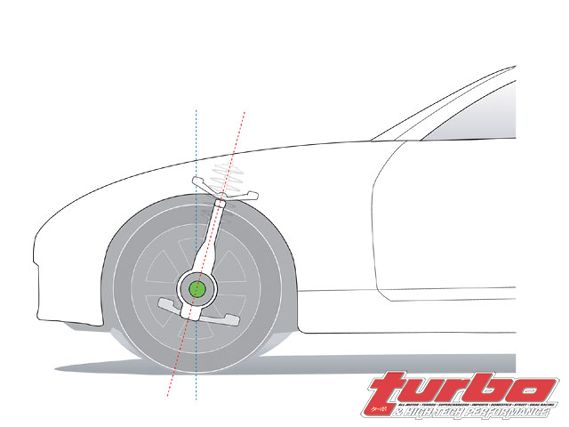 | caster
| caster
Tip 4: Corner balance
Corner balancing is the adjusting of the weight of all four wheels so the right to left and left to right crossweight percentages are equal diagonally across the car. This is done so a car's understeer/oversteer balance is the same in both right- and left-hand turns. It's an important step in chassis setup but is often ignored by all but the savviest tuners. Corner balancing is one of the main advantages a coilover suspension offers when compared to a stock-type spring suspension kit. Corner weights are adjusted by rolling a car up onto electronic scales that weigh each wheel individually. With the driver's weight in the car, the spring perches are adjusted; raising the perch increases the weight of the adjusted wheel, lowering decreases it. The weights are fiddled until they're as close to equal from side-to-side as possible with equal crossweights.
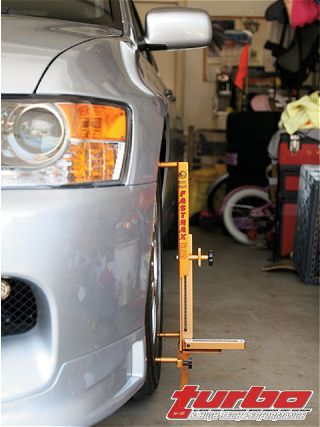 | Camber is the inward or outward tilt of the top of the wheel when viewed from this angle. Notice the EVO's negative camber. The right amount of camber will keep the tire flat and engaged while too much will result in a loss of traction during braking and accelerating, not to mention prematurely worn tires.
| Camber is the inward or outward tilt of the top of the wheel when viewed from this angle. Notice the EVO's negative camber. The right amount of camber will keep the tire flat and engaged while too much will result in a loss of traction during braking and accelerating, not to mention prematurely worn tires.
There almost isn't a distinctly unique way to set up an AWD vehicle other than just stepping back and taking cues from the FWD platform - if you haven't figured it out already, most AWD vehicles are pretty similar to FWD ones. How a car is set up handling-wise can be as unique as an individual driver's style. Drivers should use this guide to help them set up their AWD cars to suit the situation and their personal preferences. Read, adjust, experiment, go faster!
Camber-Setting Guidelines (Measured In Negative Degrees) DRIVING USE FRONT REAR EVO, DSM, WRX, STi (MacPherson strut) GT-R (multi-link) EVO, DSM, GT-R
(multi-link) 1.5-2 AGGRESSIVE STREET DRIVER 2 1.75 1 1-1.5 WEEKEND
WARRIOR 2-2.5 2-2.5 1-1.5 1.5-2 SERIOUS AUTOCROSSER 3-4.5 3-4 1.5-2 1.5-2
Camber-Setting Effects NEGATIVE CAMBER JUST RIGHT TOO MUCH - Reduced tread lift and wheel tilt - Reduced braking traction - Increased camber thrust - Reduced acceleration traction - Increased tramlining and crown sensitivity - Excessive inside tire wear
Toe-Setting Guidelines (Measured In Inches) DRIVING USE FRONT REAR EVO, DSM, WRX, STi GT-R (OR REAR TORQUE BIASED AWD) EVO, DSM, WRX, STI GT-R (OR REAR TORQUE BIASED AWD) AGGRESSIVE STREET DRIVER 0 1/16 in 0 1/8 in WEEKEND
WARRIOR 0-1/8 out 0 0 1/8 in SERIOUS AUTOCROSSER 1/8-1/4 out 1/8 out 0 1/8 in
Toe-Setting Effects FRONT TOE-OUT JUST RIGHT TOO MUCH - Reduced understeer on turn-in - Braking twitchiness - Increased steering input response - Straight line instability, especially - Reduced toe-in under throttle tendency over single-wheel bumps or split-traction surfaces - Refusal to turn, unrecoverable understeer
FRONT TOE-IN JUST RIGHT TOO MUCH - Increased stability - Wandering during braking - Refusal to turn-in, or quick turn-in and immediate understeer REAR TOE-OUT ( Rare for AWD vehicles) JUST RIGHT TOO MUCH - Improved mid-turn rotation, preventing - Violent oversteer on throttle (some understeer-induced front tire overload drifters do this on purpose) - Violent rotation on throttle lift or during trail braking into a turn JUST RIGHT TOO MUCH - Ability to apply throttle sooner and harder, - Sluggish responsiveness and mid-turn more manageable oversteer understeer tendency - Rocking, wandering feeling on turn-in; unstable and awkward. CASTER-SETTING GUIDELINES EVO, DSM, WRX, STi {{{GT}}}-R (OR REAR TORQUE BIASED AWD) DEGREES POSITIVE CASTER 4-6 5-6 CASTER-SETTING EFFECTS POSITIVE CASTER JUST RIGHT TOO MUCH - Improved straight-line stability - Increased steering effort - Sharpened turn-in - Increased understeer from - Improved traction throughout turn mid-turn onward - Increased torque steer